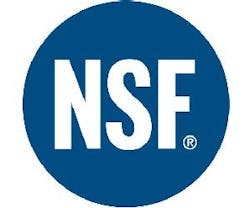NSF Intl. and Trucost Release New Carbon Emissions Report
NSF Intl., a public health and safety organization, and Trucost Plc, a global provider of environmental data and analysis, announced the availability of a new report entitled, Carbon Emissions – Measuring the Risks, which examines the greenhouse-gas (GHG) emissions of S&P 500 companies in a variety of sectors, including industrial goods and services, chemicals, food and beverage, healthcare, personal and household goods, automobiles and parts, and retail.
The report will be especially helpful for companies in the United States that will soon have to pay for GHG emissions under the planned cap-and-trade program, an approach used to control pollution by providing economic incentives to companies achieving reductions in pollutant emissions.
“Carbon-intensive companies will be most exposed to carbon costs under the cap-and-trade program to be introduced in 2012 under the draft American Clean Energy and Security Act of 2009,” says Koen Bontinck, vice president at NSF Sustainability Services. “The goal of this report is to not only provide companies with an affordable analysis of their current operations and exposure to carbon costs, but also to help them implement sustainable business practices and verify their GHG emissions data in preparation for the new regulations.”
The report is based on findings from Trucost’s study, Carbon Risks and Opportunities in the S&P 500, which assessed GHG emissions, carbon intensity, and exposure to carbon costs of S&P companies internationally, using publicly disclosed information.
Key components of the Carbon Emissions – Measuring the Risks report include discussions on carbon benchmarking and how carbon intensity can be used to assess a company’s carbon emissions relative to its sector peers; financial risk and how calculating carbon costs relative to earnings can help identify potential profit risk; other environmental impacts; and strategic implications and how companies with more energy efficient operations and supply chains will be well-positioned during the shift to a low-carbon economy to attract investors and increase market share.
“Climate change represents serious challenges to the environment, as well as risks and opportunities to U.S. corporations. The first step in mitigating those risks is to calculate carbon emissions and their potential costs from operations and supply chains,” says Malcolm Fox, vice president, corporate services at Trucost, an NSF Intl. partner. “Industry by industry, this report presents those impacts and identifies critical strategies to prepare for upcoming legislation and turns risks into a competitive advantage. For example, the average industrial service firm needs to prepare for the fact that over 70 percent of their carbon emissions are embedded in their supply chain, representing a significant financial risk.”
Key findings among the industrial goods and services sector include: The average major U.S. industrial goods/services company emits 1.2 million metric tons of GHG annually; over 70 percent of emissions originate from supply chains, representing serious financial exposure as costs are passed on to manufacturers; the cost of carbon may reach as high as 18 percent of earnings for some firms, as measured by earnings before interest, taxes, depreciation, and amortization (EBITDA); and companies that compete with more carbon-efficient peers could lose market share.
To view the free report, visit www.nsf.org/info/sandpcarbonemissionsreport. To find out more about NSF Intl. and Trucosts’s sustainability services, visit www.nsfsustainability.org.
